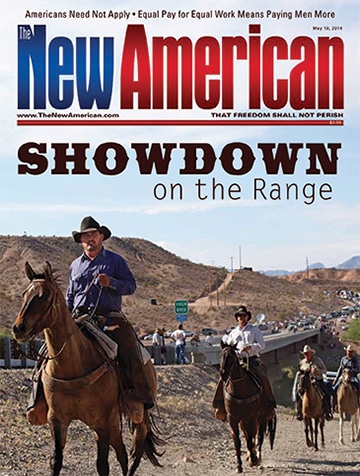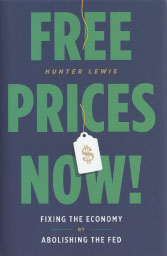Honesty Is the Best Economic Policy
Free Prices Now!: Fixing the Economy by Abolishing the Fed, by Hunter Lewis, Edinburg, Virginia: AC2 Books, 2013, 276 pages, hardcover.
“Five years after the global economy was falling at its fastest rate, Western economies are still failing to gain much-needed momentum, despite the efforts of central bankers on both sides of the Atlantic,” the New York Times reported in November.
There is no question that the economy remains sluggish. But perhaps it is not struggling despite central bankers’ efforts but because of them. That is the thesis of Hunter Lewis’s Free Prices Now! Fixing the Economy by Abolishing the Fed. The book makes the case that the Federal Reserve’s monetary machinations, coupled with other government interventions in the marketplace, are precisely what has led to the current economic malaise and that the solution to the economy’s woes is to end the Fed, to reform the banking system, and to get the government out of the business of picking winners and losers in the marketplace.
Lewis knows whereof he speaks. He is a co-founder of global investment firm Cambridge Associates, LLC and even spent some time at that hotbed of central planning, the World Bank. He has written nine books and numerous articles on the subjects of economics and moral philosophy.
Those two topics might at first glance seem to be an odd pairing. It is often said that economics — particularly Austrian economics, of which Lewis is an adherent — is “value-free.” That is, it may tell us that an increase in the minimum wage will lead to more unemployment, but it does not tell us whether it is therefore either moral or immoral to hike the minimum wage.
For Lewis, however, economics and morality go hand-in-hand. He is particularly passionate about the need for honesty in the marketplace.
“The most reliable barometer of economic honesty is to be found in prices,” Lewis writes. “Honest prices, neither manipulated or [sic] controlled, provide both investors and consumers with reliable economic signals. They show, beyond any doubt, what is scarce, what is plentiful, where opportunities lie, and where they do not lie.”
The problem, of course, is that humans do not always want to tell the truth. But since prices in a free market never lie, those who wish to deceive in the marketplace must call upon the state to manipulate prices in their favor through various schemes, from outright price controls to inflation and regulation. Besides aiding their friends in the private sector, government officials have their own incentives to prevaricate, not least of which is concealing the true cost of their profligacy.
Governments could not get away with their deceptions, however, without accomplices in academia and media. These “modern day Magi,” Lewis says, “confidently argue that dishonest prices are really honest; honest prices are really dishonest; the resulting chaos is really order; and a future filled with jobs and plenty lies ahead with just a few more manipulations and controls.”
It is no coincidence, therefore, that the progenitor of today’s “Magi,” British economist John Maynard Keynes (1883-1946), once declared, “I remain, and always will remain, an immoralist.” Lewis writes that Keynes did not trust the common man to do the right thing, instead believing that government experts must “guide the masses in the right direction and … , if necessary, resort to a bit of seduction or mendacity to achieve necessary ends” — hardly a problem for someone with no scruples.
For example, Keynes argued that unemployment develops because people want unreasonably high wages. To counter this, he said, central banks should simply print more money and convince the people that the new money is as good as the old. Inflating the money supply allows wages to remain nominally high while stealthily sapping them of their purchasing power. Such methods, which Keynes called economic “tricks,” are “guileful and manipulative,” asserts Lewis.
Not surprisingly, these methods — “stimulating” the economy by inflation and massive deficit spending, combined with bailouts of private interests — introduce enormous amounts of dishonesty into the economic system. They distort prices and create bubbles in certain sectors. And when those bubbles burst, rather than letting the market correct itself, the central bank “just doubles down, lowers interest rates further, floods the economy with even more money, all in the hope that it can generate even more borrowing and spending,” observes Lewis. “How can anyone think that this will work?”
It doesn’t work, as evidenced by its failure to end the Great Depression, the current recession, and other economic downturns over the years. Japan, for instance, has been employing Keynesian methods on an unprecedented scale since its economy crashed in the 1980s — to no avail. “In sharp contrast,” notes Lewis, “other Asian economies that crashed in the late 1990s side-stepped the standard Keynesian ‘remedies’ and recovered swiftly.”
Another perverse result of Keynesian methods is the rise of crony capitalism, that is, an economic system in which the government manipulates prices to favor its pals in the private sector. Often this is done in the name of equality; but as Lewis remarks, “the result is not a more equitable or successful economy. It is, instead, an increasingly corrupted economic and political system.” In trying to equalize outcomes, “we create an epidemic of lying, cheating, theft, and corruption, with more and more people trying to get something for nothing, relying not on what they can do, but on whom they know in government.”
All of these interventions are aided and abetted by the central bank, which, in the case of the United States, is the Federal Reserve. The Fed creates money out of thin air, depleting the value of existing currency — so much so that, according to Lewis, the dollar has lost 97 percent of its purchasing power since the Fed came into existence in 1913. The Fed drives down interest rates, creating bubbles and inevitable busts. It buys government bonds, injecting more money into the economy and concealing the true cost of federal spending. It has lately taken to bailing out failing corporations. And those are just its (arguably) lawful activities. As Lewis points out, much of what the Fed does is clearly illegal.
The banking system in general is a hopeless tangle of “rules, subsidies, guarantees, and outright price controls,” Lewis writes. It’s hard to tell if banks are even earning profits, he says. “The truth is that almost nothing in banking today is real anymore. It long ago lost any solid connection to market reality and is all fictional to one degree or another.”
If, as Lewis contends, today’s economic disaster, which is certain to become even worse as the welfare state collapses of its own weight, is the result of central banking and other government interventions, then the solution is obvious: Get rid of the Fed and drastically scale back the government. That is precisely what Lewis recommends.
He also calls for banking reform — not the Dodd-Frank method of piling on more bureaucracy that only ends up favoring the big banking interests, but bringing an end to fractional reserve banking, whereby banks keep in reserve only a fraction of the money needed to pay their depositors on demand, using the money that should have been kept in reserve to create additional loans. End fractional reserve banking, he maintains, and banks will be solvent at all times, eliminating any perceived need for government deposit insurance and, in turn, all other government controls.
Echoing former congressman Ron Paul and Ludwig von Mises Institute chairman Llewellyn Rockwell, whom he quotes at length, Lewis stumps for ending government control over the money supply and allowing the market to determine what will be used as money, thereby preventing it from being subject to political manipulation.
Finally, Lewis argues for “one overarching principle” in making all economic policy: “that prices must be free, fully emancipated from government.” That’s certainly a tall order in this day of “quantitative easing,” corporate bailouts, subsidies, and countless other interventions. But considering that the opposite approach has been tried and has failed miserably, maybe it’s time to give freedom a chance.
Free Prices Now! is a relatively easy read. Lewis writes in a direct, lucid style, with none of the obfuscatory terminology so often found in economics literature. He does not assume that the reader has a prior understanding of economics, instead spending several chapters laying out the basics of supply and demand and how they relate to prices, profits, and losses. That, combined with his easy-to-read style, makes Free Prices Now! something even a high-school student could comprehend and benefit from.
A few minor criticisms are, however, in order. Lewis has a tendency to overuse block quotations, even going so far as to use them for single words at times, which can interrupt the flow of the writing a bit. Also, the book would have benefited from some more careful editing. My review copy contained several spelling and punctuation errors and one instance of misuse of a homophone (“sews the seeds”). Those relatively small quibbles notwithstanding, I unreservedly recommend Free Prices Now! to anyone who wants to understand how the economy got into its current state and, more importantly, how to get it out.


